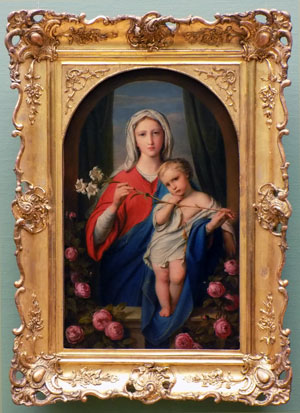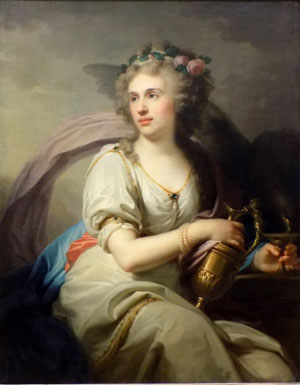“Images of Flora” exhibition opened in the Tretyakov gallery on January 25, 2017. The heart of the exposition is “Portrait of a woman in the image of Flora”, probably painted by an artics from the Academy of Leonardo da Vinci. It is accompanied by Russian mythologized portraits of women with “speaking” flowers, attracting our attention to floral symbolism. The exhibition will run until March 26, 2017.
The unknown author of the XVI century painted the aforementioned portrait in the style of “Flora” of Italian artist F. Melzi. Due to the style of painting is similar to the paintings of Leonardo da Vinci, an Italian specialist in the art of Da Vinci, historian Carlo Pedretti believes that it belongs to the graduate of the Academy of the famous artist. Today the portrait is in a private collection in Russia.
Tretyakov gallery exposition is conceived as an element of a series of chamber exhibitions, which shows the part of the vaults of the Museum and open it fine, but familiar to all of us collection from new point of view, and tells the history of Russian art as a whole.
The image that inspired artists in floral style of painting, derives from the Roman (Sabinsky) pagan beliefs. According to Roman world perception, every living being had a guardian spirit, and every process – the idol. Flora was in charge of all flowering including flowering cereals. The cult of Flora was well developed, and over time it absorbed the cult of the Greek Chloris (Chlorides). Spring festivities dedicated to the goddess, was called floralia, and had a frivolous nature.

Fashion of Roman culture symbols came to Russia along with Western European classicism. The nobility receiving a classical education, reading the ancient classics, takes the language of Roman and Greek cults, absorb the images of gods and heroes, and gradually begins to build a classical style residences and surround itself with items and clothing in the antique style. The fashion for portraits in the manner of Greek and Roman gods, in particular the image of Flora, appeared in Russia.
A sample of that is a sculpture of lady decorated with flowers, discovered in the ruins of a noble mansion.Meanwhile, paganism has returned to Christian soil. So part of the “floral” art exhibition painted with Christian themes.
“It’s not an icon. As art specialist say, it is a religious scene,” explained for “E Vesti” readers S. V. Usacheva, PhD, senior researcher of Tretyakov gallery and the curator of the exhibition.
“For example, Borovikovsky, he created a lot of this kind of paintings. They are mostly intended for the Church, but in the strict sense, they are no longer called the icons. The style, the manner of the image, even some of the iconographic features – all this makes this kind of an icon to the art of the European Renaissance and Baroque… They could be made to house churches, or more often for interior,” she said.

The Virgin and Child with roses F.A. Bruni
Svetlana Usacheva also questioned the fact that they were sanctified by the Orthodox Church: “It is a picture. The development trend of secular painting invades all his being in religious art. Since the XVIII-th century Western European trends, “picture” form, style penetrate into our academic painting. The icon for a very long time developed independently and was based on Byzantine tradition”.Thus, the exhibition in the Tretyakov gallery, despite its intimate character, it gives great food for thought about matters of faith and philosophy of art.





